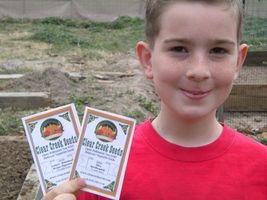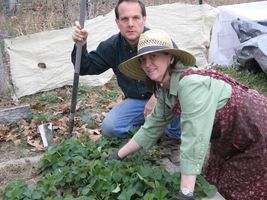Gardening and producing food is one of the topics that I’d love to cover on this site, but I just don’t have the knowledge to do so! I was so excited when the family behind Clear Creek Seeds was willing to share their knowledge with all of us!
Click on over to their site and learn more about all the heirloom variety seeds they have, as well as read their informational articles on Raised Beds, Soil Types, and check out the most nutritious veggies and their top ten varieties!
As you start a large garden or a small raised bed this spring, I would encourage you to support a small home-based business who cares about food quality and purchase your seeds here!
How and why did you get started with Clear Creek Seeds?
The idea of Clear Creek Seeds evolved over time as we became increasingly concerned with events around us. With the realization of growing our own food
becoming a necessity, it was time to research what was involved in producing the best food possible. The same message was heard throughout our learning
process. Start with good quality heirloom seeds for the best tasting vegetables and stay away from GMOs.
Since we wanted the best results for the amount of work it would require to achieve this, we listened. Since then we have come into contact with an alarming amount of people who think the same way but don’t know where to start. So we decided to be a source for the information and of the actual seeds. We transfer our knowledge and that of others to our website and provide what we feel are the highest quality seeds available. Now we have Clear Creek Seeds.
Why are more and more people realizing the importance of heirloom seeds and choosing to seek out these varieties for their gardens?
More people are becoming aware of what is happening to our food supply.
A little background; remember that before the industrialization of agriculture, a much wider variety of plant foods was grown for human consumption. Today most food crops are grown in large, monocultural plots. In order to maximize consistency, few varieties of each type of crop are grown. These varieties are not grown for their taste or nutritional value but for their ability to withstand mechanical picking, cross-country shipping, and tolerance to drought, frost, or pesticides.
Genetically modified and hybrid seeds are used to guarantee high consistent productions. This comes with consequences ranging from health issues to the control of all seed distribution. Without the ongoing growing and storage of heirloom plants, the large seed companies and the government will control all seed distribution. Most of their seeds, if not all, when regrown, will not be the same as the original plant, thus ensuring the dependency on corporate seed
distributors for future crops. As the population wakes up to this, a movement has sprung up to keep heirloom varieties alive.
How does the nutritional content between your seeds and commercial seeds differ?
As more health related issues are being traced back to our consumption of processed foods more people are waking up and doing their own research finding that commercially offered vegetables are pretty to look at but contain less vitamin content and trace minerals than most existing heirloom vegetables. The vegetables we now find in our grocery stores are the end result of much selective breeding but unfortunately vitamin/mineral content and taste is never a part of the selection criteria. Heirloom seeds produce plants true to their source which are unmodified, natural, and are rich in nutritional value.
What would you recommend someone grow who can only grow a small container garden?
Almost any vegetable can be adapted for growing in a small container.
Some ideas for containers and pots:
- Bush or dwarf varieties
- Vegetables that take up little space (such as carrots, radishes and lettuce)
- Crops that bear fruits over a long period of time (such as tomatoes and peppers).
Things to remember though are that dark colored containers absorb heat which could possibly damage the plant roots; use larger containers for larger vegetables like tomatoes and eggplants; and pots and containers always require more frequent watering than plants in the ground. With a little planning and research you can have a bountiful garden in the smallest of places.
Do you have any favorite tips for getting kids involved in the garden?
Kids need to feel involved and have a degree of ownership that matches their age level. Everyone likes to see the rewards of their hard work so involve them early in the planning process and make a point of giving them credit during harvest. There is a lot of learning in between also. Give them a small bed to call their own and let them make the decisions. If they are diligent and responsible, they will be rewarded with a good harvest that will be displayed proudly on the dinner table. Many virtues can be worked on in the garden.
I hope that you’ve learned as much from this as I did!
Now, what plans do all of you have for your gardens this year?

Learn how to heal leaky gut

60-page ebook of all my best GAPS Diet (Gut and Psychology Syndrome) articles all in one place.


![IMG_1754 [320x200]](https://healthhomeandhappiness.com/wp-content/uploads/2011/03/img_1754-320x200-150x150.jpg)

I just got some of their seeds and I am so excited to plant my garden!!
I always strived to plant using heirloom seeds in my Freestone garden. But because of the weather patterns I sometimes had to choose other seeds for success.
There is a destination right here in our Bay Area backyard called ‘The Seed Bank’ in Petaluma. The Seed Bank is in a spectacular historical building on the corner of Petaluma Boulevard and Washington Street. Although I no longer have an area to plant gardens I still plant a small amount of greens in planter boxes and will try heirloom varieties this year.
Thanks for this post Cara ~ be well.
I am excited to get back to gardening this year — thanks for the info about the seeds. I do have one other heirloom seed catalog but I will check out this company too. We had snow when we woke up Saturday morning — but it was all gone by the afternoon. I’m ready for spring here in Virginia!!
We are very excited about the new seed season. Thanks for all your support during our first year. Also, we’ve been on the GAPS diet a year and its just normal now. I do miss a few of my old favorite foods but I feel a lot healthier by avoiding them. We’ve become real creative with the no-grains part.